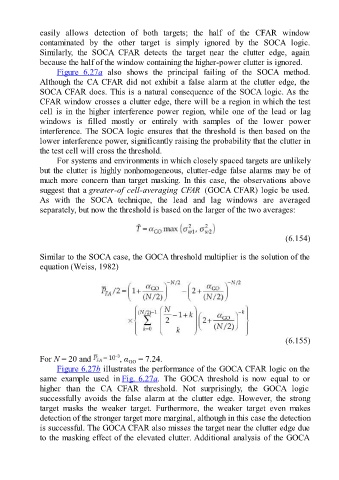Page 519 - Fundamentals of Radar Signal Processing
P. 519
easily allows detection of both targets; the half of the CFAR window
contaminated by the other target is simply ignored by the SOCA logic.
Similarly, the SOCA CFAR detects the target near the clutter edge, again
because the half of the window containing the higher-power clutter is ignored.
Figure 6.27a also shows the principal failing of the SOCA method.
Although the CA CFAR did not exhibit a false alarm at the clutter edge, the
SOCA CFAR does. This is a natural consequence of the SOCA logic. As the
CFAR window crosses a clutter edge, there will be a region in which the test
cell is in the higher interference power region, while one of the lead or lag
windows is filled mostly or entirely with samples of the lower power
interference. The SOCA logic ensures that the threshold is then based on the
lower interference power, significantly raising the probability that the clutter in
the test cell will cross the threshold.
For systems and environments in which closely spaced targets are unlikely
but the clutter is highly nonhomogeneous, clutter-edge false alarms may be of
much more concern than target masking. In this case, the observations above
suggest that a greater-of cell-averaging CFAR (GOCA CFAR) logic be used.
As with the SOCA technique, the lead and lag windows are averaged
separately, but now the threshold is based on the larger of the two averages:
(6.154)
Similar to the SOCA case, the GOCA threshold multiplier is the solution of the
equation (Weiss, 1982)
(6.155)
For N = 20 and , α = 7.24.
GO
Figure 6.27b illustrates the performance of the GOCA CFAR logic on the
same example used in Fig. 6.27a. The GOCA threshold is now equal to or
higher than the CA CFAR threshold. Not surprisingly, the GOCA logic
successfully avoids the false alarm at the clutter edge. However, the strong
target masks the weaker target. Furthermore, the weaker target even makes
detection of the stronger target more marginal, although in this case the detection
is successful. The GOCA CFAR also misses the target near the clutter edge due
to the masking effect of the elevated clutter. Additional analysis of the GOCA

